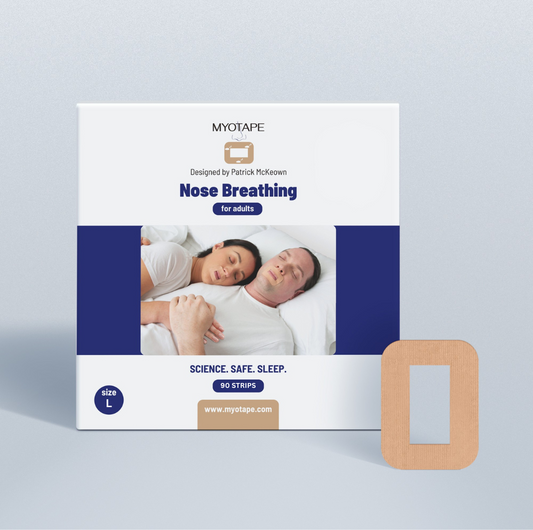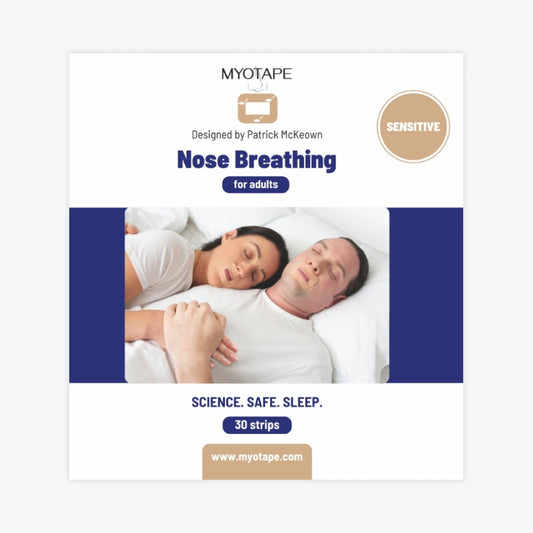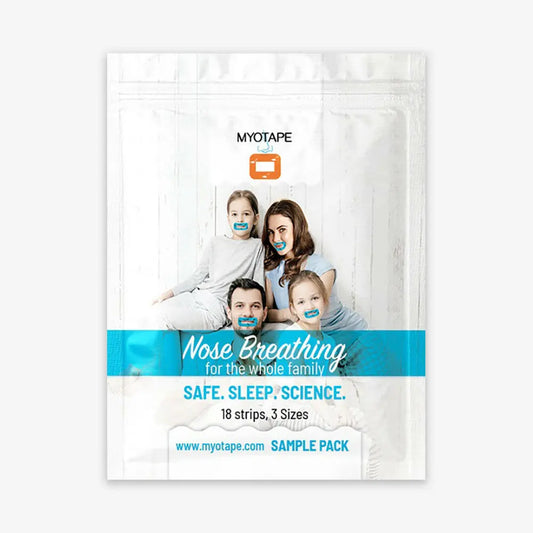What does it mean to breathe better? Breathing is a basic yet vital process that significantly affects our overall health. So, breathing through your nose is the only way to breathe better, as it is the natural and healthier way to breathe. However, many people find themselves breathing through their mouths, both day and night. This can lead to problems like dry mouth, snoring, and poor sleep quality.
Mouth breathing can be harmful, and we are now starting to realize the benefits of nose breathing. However, changing this habit can be challenging. One method that is gaining attention is mouth taping, which involves placing a piece of tape over the mouth to encourage nasal breathing, not just during sleep but throughout the day as well.
People are curious if mouth taping can really help them train to breathe better through their noses. This article will explain how mouth taping works, its potential benefits, and if mouth taping can train you to breathe better. If you're looking for ways to improve your breathing habits and overall health, read on to find out if mouth taping might be the solution for you.
What is Mouth Taping, and How Does it Work?
Mouth taping is the practice of applying a small strip of adhesive tape over your lips to keep your mouth closed, encouraging nasal breathing. This technique is often used during sleep but can also be applied during the day to help train better breathing habits.
A 2020 study explored the effectiveness of lip tape in assessing nasal breathing. Researchers found that most participants, including children who habitually breathed through their mouths, could comfortably breathe through their noses for at least three minutes with their mouths taped. This suggests that even habitual mouth breathers can adapt to nasal breathing when their mouths are taped.
Mouth taping works by physically keeping your mouth closed, which encourages you to breathe through your nose. Placing a small strip of adhesive tape over your lips acts as a gentle reminder to maintain nasal breathing. This simple action can help prevent issues associated with mouth breathing, such as dry mouth, snoring, and disrupted sleep.
Nasal breathing offers several advantages over mouth breathing. Your nose filters out dust, allergens, and other particles while also regulating the temperature and humidity of the air you breathe. This helps protect your lungs and improve oxygen uptake. Additionally, nasal breathing boosts the production of nitric oxide, a molecule that enhances blood flow and has antimicrobial properties.
Things to Consider Before Mouth Taping
Before you start mouth taping, ensure it's safe and suitable for you. Here are some key points to consider:
Nasal Breathing Capability:
- Test First: Make sure you can comfortably breathe through your nose with exercises like the Buteyko Method's nose unblocking exercise.
- Consult a Specialist: If you have difficulty, especially during physical activity, consult a doctor or ENT specialist for issues like chronic nasal congestion or a deviated septum.
Potential Risks and Precautions:
- Breathing Issues: Not suitable if you have nasal congestion or other breathing problems.
- Skin Irritation: Adhesive tape can cause irritation; use medical-grade, hypoallergenic tapes.
- Discomfort: Mouth taping might feel claustrophobic or uncomfortable, especially if you have anxiety. Although you can get used to a mouth tape over time.
- Sleep Disruption: Initial discomfort might disrupt your sleep.
Health Conditions:
- Consult Your Doctor: If you have heart issues, anxiety, panic disorders, or sleep apnea, speak to your doctor before trying mouth taping.
- Avoid for Children: Not recommended for children or adolescents.
- Acid Reflux or Vomiting: Mouth taping can be dangerous if you have acid reflux or are vomiting.
Tape Selection:
- Use Proper Tape: Always choose medical-grade, hypoallergenic tapes designed for mouth taping. If you have a beard, you can learn about the guide for mouth taping with a beard.
With these factors, you can determine if mouth taping is a suitable and safe option for improving your breathing patterns.

Can A Mouth Tape Train You to Breathe Better?
Yes, mouth tape can train you to breathe better by encouraging nasal breathing during sleep and throughout the day. This simple technique involves placing a small piece of adhesive tape over your lips to keep your mouth closed, thereby promoting nasal breathing. But why can mouth taping make you breathe better, and does a mouth tape train you effectively?
Why Mouth Taping Can Help Improve Your Breathing
Mouth taping can be a transformative tool for enhancing your breathing by promoting nasal breathing. When you place a small piece of tape over your lips to keep your mouth shut, you can break the habit of mouth breathing. Doing so encourages your body to rely on nasal breathing, which is essential for filtering, warming, and humidifying the air you inhale.
Breathing re-education is a key benefit of mouth taping. Even children who persistently breathed through their mouths, despite having no nasal obstruction, showed immediate improvement in their nasal breathing habits when they used lip tape. This straightforward yet profoundly effective method establishes full-time nasal breathing, which is crucial for proper craniofacial and airway development.
The 2020 study we mentioned earlier also revealed that many habitual mouth breathers can actually breathe through their noses when encouraged by a tape. The study involving 633 participants found that over 80% of those who typically mouth-breathed could comfortably breathe nasally for at least three minutes with their mouths taped. This shows that mouth breathing is usually a habit, not a physical problem, and it highlights how possible it is to retrain your breathing with methods like mouth taping.
Does A Mouth Tape Train You Effectively?
Many people habitually breathe through their mouths. This habit can lead to a range of issues, including dry mouth, snoring, and poor concentration. Mouth taping has been shown by research to alleviate mouth breathing and improve nasal breathing.
A study by Huang and Young (2015) tested a special mouth patch to help people with mild sleep apnea and mouth breathing. Thirty patients used this patch to keep their mouths closed while sleeping.
The results were impressive: their daytime sleepiness scores dropped, snoring got quieter, and their sleep apnea events were cut nearly in half. These findings suggest that using a mouth-sealing device like mouth tapes can effectively improve breathing patterns, reduce snoring, and treat habitual mouth breathing.
A recent 2022 study also found that mouth taping during sleep significantly improved snoring in mouth-breathers with mild OSA by reducing the apnea/hypopnea index (AHI) and snoring index (SI) by about half. Thus, mouth taping can train you to breathe effectively, even a lot of celebs also mouth tape.
Are All Mouth Taping Beneficial?
Nonetheless, it is worth mentioning that conventional mouth taping can be detrimental for some people. The reason is because of a phenomenon called mouth puffing. Mouth puffing occurs when a person instinctively tries to expel air through their mouth during sleep, usually due to airway restriction. This can lead to discomfort and potentially worsen breathing disturbances if the mouth is completely sealed. For some, mouth puffing is a natural mechanism to release excess air when nasal breathing alone isn't sufficient.
Products like MyoTape, which gently surround the lips without completely sealing them, allow for mouth puffing while still encouraging nasal breathing, making it a safer and more comfortable alternative.
To sum up, mouth taping can be an effective tool for retraining your breathing patterns. By consistently using mouth tape, your body is gently reminded to use the nose for breathing, which has several health benefits.
Nasal breathing filters out dust, allergens, and other particles while also regulating the temperature and humidity of the air you inhale. This helps protect your lungs and improve oxygen uptake. Additionally, nasal breathing boosts the production of nitric oxide, a molecule that enhances blood flow and has antimicrobial properties.
How to Train Your Breathing with Mouth Taping
To practically train nasal breathing, use a mouth tape like MyoTape for short periods during the day. This can be particularly useful for children who habitually breathe through their mouths. For example, having a child wear MyoTape for at least half an hour each day while engaged in a distracting activity like reading or watching TV can help establish the habit of nasal breathing. Combining this with breathing exercises like the Steps exercise can further reinforce nasal breathing habits.
Breathing Exercise Can Also Help Your Breathing
Breathing exercises play a crucial role in retraining your breathing patterns. Exercises like the Buteyko Method's Steps exercise can help unblock the nose and make nasal breathing more comfortable. Practicing these exercises consistently is key to developing new, healthier breathing habits. For children, incorporating games and creative activities can make these exercises more engaging and effective.

MyoTape Will Train You to Breathe at Your Best
In conclusion, mouth taping can be a valuable tool for training better breathing habits, particularly when combined with breathing exercises. And the best option to help train you to breathe nasally is MyoTape. MyoTape is a safe and innovative mouth tape designed by world-renowned breathing expert, Patrick McKeown. It gently holds your lips together, training the muscles around your mouth to keep it closed, while sleeping or awake. It also allows for mouth puffing and emergency mouth opening.
You can check out our range of effective mouth taping products designed for everyone, including mouth tape for kids, adults, those with sensitive skin, and even those with facial hair. Visit our online shop today to find the best MyoTape solution for you and start your journey to better, healthier breathing.








